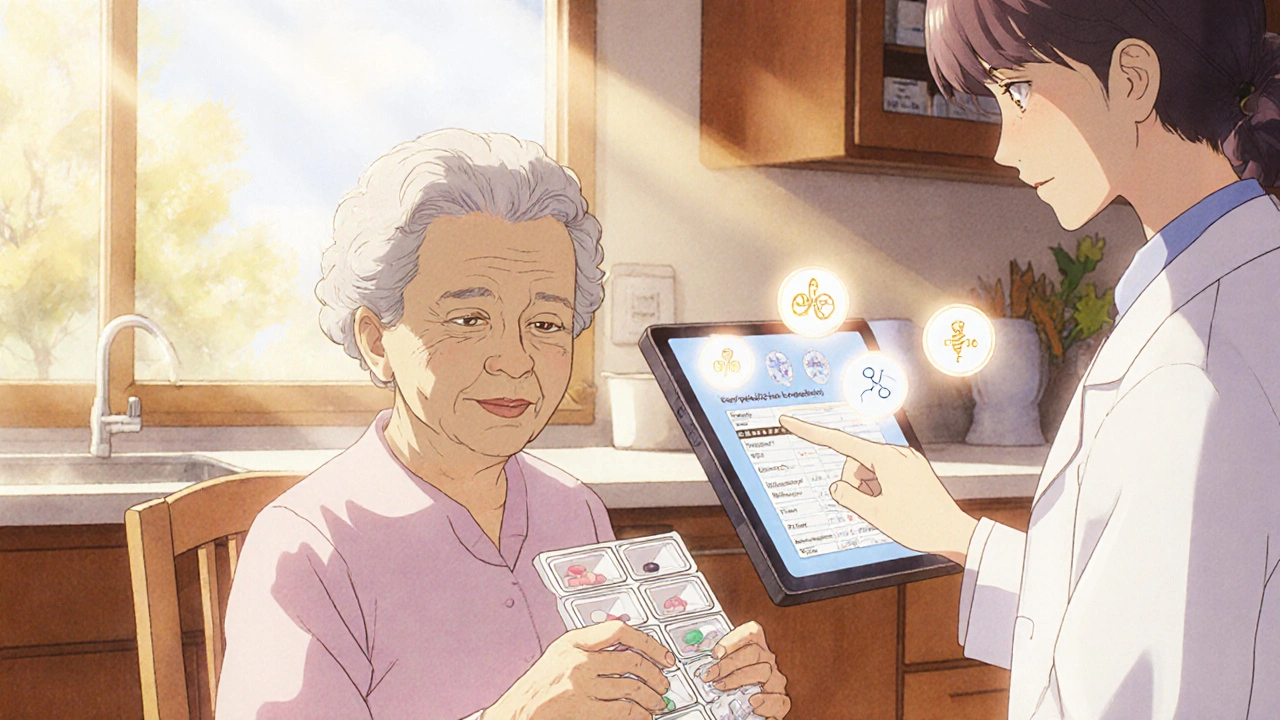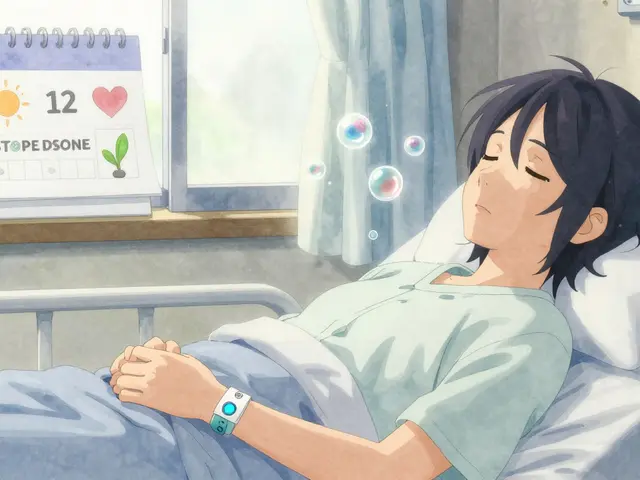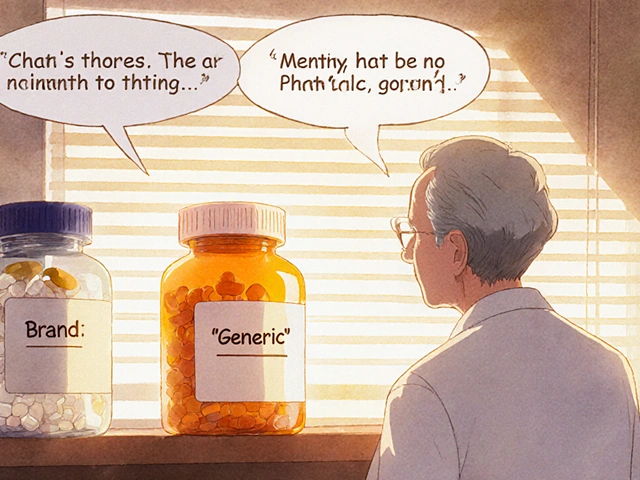Kidney Function Dose Adjuster
Why This Matters
Most drugs are cleared by your kidneys. If your kidneys aren't working well, your dose may need to be lowered. For drugs with a narrow therapeutic index (like warfarin, digoxin, or lithium), this is critical for safety.
Important: This calculator estimates kidney function only. Always consult your doctor or pharmacist before changing any medication dose.
Calculate Your Kidney Function
Your Estimated Kidney Function
Estimated Creatinine Clearance:
Dosage Adjustment Needed:
Your kidneys process of your medications.
For drugs with a narrow therapeutic index (NTI), this may require dose reduction.
Getting the right dose of medication isn’t just about following the label. It’s about finding the sweet spot where the drug works without hurting you. Too little, and it does nothing. Too much, and you could end up in the hospital. For many people, especially those on multiple drugs or with chronic conditions, this balancing act is constant-and often confusing.
Why One Size Doesn’t Fit All
Your body isn’t like the average patient in a clinical trial. Those trials mostly include healthy adults under 65, with no other illnesses or medications. But real life? You might be 78, have kidney trouble, take five pills a day, and weigh 20% more than the study population. The dose printed on the bottle? It might be completely wrong for you. That’s why dose adjustment exists. It’s not a mistake or a flaw in the system-it’s the standard of care for many drugs. Some medications, like warfarin, digoxin, and phenytoin, have what’s called a narrow therapeutic index. That means the difference between a helpful dose and a dangerous one is tiny. With digoxin, just two and a half times the normal dose can kill half the people who take it. There’s no room for guesswork.What Factors Actually Change Your Dose?
Doctors don’t adjust doses randomly. They look at real, measurable things:- Kidney function: Most drugs leave your body through your kidneys. If your creatinine clearance is low (a common sign of aging or disease), your dose needs to drop. A 70-year-old with mild kidney impairment might need 30% less of a drug than a healthy 40-year-old.
- Liver health: The liver breaks down many medications. If you have cirrhosis, your liver can’t process drugs the same way. Doctors use scores like Child-Pugh to estimate how much to cut back.
- Body weight: For obese patients, dosing isn’t based on total weight. It’s calculated using ideal body weight plus 40% of the extra weight. Taking a standard dose based on total weight can lead to overdose.
- Age: Older adults often need lower doses because their bodies process drugs slower. Even if their kidneys look fine, their metabolism has changed.
- Genetics: About 25% of commonly used drugs are affected by gene variations. Some people metabolize drugs too fast (so the drug doesn’t work), others too slow (so it builds up to toxic levels). This is especially true for antidepressants, blood thinners, and pain meds.
- Other medications: If you’re on five or more drugs-common in older adults-you’re at risk for interactions. One drug can block another from being broken down, causing dangerous spikes in blood levels.
NTI Drugs: When a Mistake Can Be Deadly
Narrow Therapeutic Index (NTI) drugs are the most dangerous to get wrong. They include:- Warfarin (blood thinner)
- Digoxin (heart medication)
- Phenytoin (seizure control)
- Lithium (mood stabilizer)
- Cyclosporine (transplant drug)
Statins, Painkillers, and the Myth of “More Is Better”
Not all dose adjustments are about avoiding toxicity. Sometimes, the issue is that higher doses don’t help-but they do cost more and cause more side effects. Take statins. In 2013, guidelines pushed for high-dose statins in everyone with heart disease risk. But research from Oregon State University showed the actual benefit was tiny: for every 100 people on high-dose statins, only one avoided a heart attack. Meanwhile, muscle pain, liver stress, and diabetes risk went up. The same pattern shows up with opioids, antidepressants, and even some blood pressure meds. More isn’t always better. Sometimes, it’s just more expensive-and more risky.
What Happens When You Miss a Dose or Take Too Much?
Patients often panic when they miss a pill. Should they double up? Skip the next dose? Take it late? There’s no universal rule. For some drugs, like antibiotics, missing a dose reduces effectiveness. For others, like blood pressure pills, skipping one day won’t cause immediate harm-but skipping several might. With NTI drugs like lithium or digoxin, even one missed dose can trigger a rebound effect. The best advice? Call your pharmacist. They know how your specific drug behaves. A quick text or call can prevent an ER visit. Many pharmacies now offer free dose counseling for patients on complex regimens.How Pharmacists Are Changing the Game
Doctors don’t have the time to track every drug interaction or calculate creatinine clearance for every patient. Pharmacists do. That’s why pharmacist-led programs are the most effective way to reduce errors. In one study, patients on five or more medications who got regular pharmacist reviews:- Had 35% fewer medication errors
- Were 22% less likely to be hospitalized
- Reported better understanding of their meds
What’s Next? The Rise of Precision Dosing
The future of dosing isn’t guesswork. It’s data. Tools like InsightRX and DoseMe use AI to predict the right dose based on your age, weight, genetics, kidney function, and current meds. These systems are already used in transplant centers, where getting the dose wrong can mean organ rejection. Now, they’re starting to show up in community pharmacies. The FDA is pushing for this too. In 2022, they released new guidance asking drugmakers to prove how a drug works across different patients-not just in healthy volunteers. Real-world data from millions of patients is now being used to build smarter dosing rules. This isn’t science fiction. In the next five years, if you’re on a high-risk drug, your pharmacist might pull up a digital profile showing your predicted optimal dose based on your DNA, lab results, and even your diet.Your Action Plan: How to Take Control
You don’t have to wait for the system to catch up. Here’s what you can do today:- Know your NTI drugs. If you’re on warfarin, digoxin, lithium, or phenytoin, ask your doctor: “Do I need regular blood tests? How often?”
- Keep a full, updated list. Write down every pill, supplement, and herbal product you take. Bring it to every appointment. Don’t assume your doctor knows.
- Ask about deprescribing. “Is there a drug here I don’t really need anymore?” This is especially important if you’re over 65 or taking five or more medications.
- Use your pharmacist. Don’t just pick up your prescription. Ask: “Could any of these interact? Should I be getting blood tests?” Most pharmacies offer this for free.
- Track side effects. Keep a simple log: “Day 3: dizziness after taking pill.” This gives your doctor real data-not just “I feel fine.”
Frequently Asked Questions
How do I know if my medication has a narrow therapeutic index?
Your pharmacist or doctor can tell you. Common NTI drugs include warfarin, digoxin, lithium, phenytoin, cyclosporine, and theophylline. If your doctor says you need regular blood tests to check your levels, that’s a sign the drug has a narrow window between safe and dangerous. Don’t assume all medications require this-most don’t.
Can I adjust my own dose if I feel the medication isn’t working?
Never adjust your dose without talking to your provider. Even small changes can be dangerous with NTI drugs. If you feel a medication isn’t helping, write down your symptoms and schedule a review. Your doctor may need to switch drugs, not just increase the dose. Sometimes, the issue isn’t the amount-it’s the wrong drug entirely.
Why do I need blood tests for some drugs but not others?
Blood tests are used when the drug’s effect is hard to measure by symptoms alone. For antibiotics, you know if the infection is clearing. For warfarin or digoxin, you can’t feel whether your levels are safe. Blood tests give objective data. For drugs with wide safety margins-like penicillin or most antidepressants-blood tests aren’t needed because side effects are rare and obvious if they happen.
Does being overweight mean I need a higher dose?
Not always. For many drugs, especially those that affect the brain or heart, dosing is based on ideal body weight-not total weight. For example, if you’re 30% overweight, you might only need a 10-20% increase, not a 30% increase. Some drugs, like insulin or certain antibiotics, are dosed by total weight, but others, like antidepressants, are not. Always ask your pharmacist how your specific drug is calculated.
Can genetic testing help me find my right dose?
Yes-for some drugs. Testing for genes like CYP2C9, CYP2C19, and CYP3A4 can show if you’re a fast or slow metabolizer. This affects drugs like clopidogrel, SSRIs, and warfarin. The NIH’s IGNITE Network is already using this in clinics for 15+ high-risk medications. If you’re on one of these drugs and have had side effects or poor results, ask your doctor if pharmacogenomic testing is right for you.
How often should my medication dose be reviewed?
At least once a year, or anytime your health changes. If you gain or lose weight, start or stop another medication, develop kidney or liver problems, or turn 65, your dose may need adjustment. Many people take the same dose for 10 years-even when their body has changed. A simple review can prevent problems before they start.







15 Comments
Been on warfarin for 8 years. My INR used to swing like a pendulum until I started seeing a pharmacist-led anticoag clinic. They tweak my dose weekly based on labs, not guesswork. My bleeding risk dropped, and I actually sleep better now. Don’t wait till you’re in the ER to ask for help.
Doctors don’t care. They just push pills. I got my dose wrong for 3 years. Now I’m on dialysis. The system’s broken. They don’t want you to know this stuff.
I’m from India, and here, most elders take 5-6 meds daily without any review. I showed this to my uncle-he’s 74, on digoxin, lisinopril, and metformin. He never knew his kidney function mattered. We got his labs done last week. His dose is being lowered now. Small steps, big difference.
The pharmaceutical industrial complex has long operated under the illusion of universal dosage norms, oblivious to the ontological uniqueness of each human organism. One’s metabolic architecture, shaped by lineage, environment, and chronology, defies the reductive calculus of clinical trial averages. To prescribe without personalization is not medicine-it is mechanistic dogma cloaked in authority.
Wait… so you’re saying doctors are just winging it?! 😱 I’ve been on lithium for 12 years and never had a blood test until last month. My mom cried when she saw the report. I’m so mad rn… I could’ve been dead. 💔
so like… if u got bad kidneys, u need less meds? but what if u r obese? then u need more? but not really? so what do u do??
This is one of the most important articles I’ve read in years. I’m a 68-year-old with diabetes and atrial fibrillation-I take seven medications. I never realized how much my kidney function affects them. I’ve scheduled a pharmacist consult for next week. Thank you for writing this. You’ve given me peace of mind.
AI dosing? FDA guidance? Wake up. This is all a cover for Big Pharma to push more expensive genetic tests and proprietary algorithms. They want you dependent on their tech. Real doctors used to adjust by symptoms. Now they rely on black-box software. They’re not helping you-they’re monetizing your vulnerability.
I’ve been a nurse for 22 years, and I’ve seen too many patients suffer because no one checked their labs. The pharmacist-led model works. It’s not glamorous, but it saves lives. If your doctor won’t refer you, go to the pharmacy yourself. Ask for a med review. Most will do it for free. You’re worth the effort.
They’re hiding the truth: your meds are designed to keep you sick. The ‘narrow therapeutic index’? That’s not a medical term-it’s a profit margin. Why else would they make you test weekly? It’s a subscription model. You’re the product. The system wants you addicted to pills and blood draws. 💡
Statins don’t work. They’re a scam. I stopped mine. My cholesterol went up. I feel great. My doctor yelled at me. Whatever.
In Lagos, many patients take expired meds or share prescriptions because they can’t afford follow-ups. This article is a lifeline. I’ve translated it into Yoruba and shared it in 3 community groups. We need more of this-clear, practical, human. If you’re on multiple drugs, you’re not broken-you’re systemically neglected. Advocate. Demand. You’re not alone.
so like… i missed my pill on tuesday and doubled it on wednesday. now i feel weird. is that why i’m crying for no reason? 😭
Oh please. You think this is new? I’ve been telling people for years that your body isn’t a lab rat. The FDA doesn’t care about you. They care about liability. And pharmacists? They’re just glorified cashiers who read from a script. Real change? That’s when we stop trusting the system and start trusting our own bodies. I stopped all meds last year. My anxiety vanished. Coincidence? I think not.
@4880: You’re right that the system’s broken-but don’t throw out the baby with the bathwater. My pharmacist doesn’t work for Big Pharma. She works for me. She called my doctor when my INR spiked. She saved my life. Tech isn’t the enemy. Apathy is.
Write a comment